Integrated Professional Skills in Digital Age: Social Media Report
VerifiedAdded on 2023/01/13
|12
|3730
|30
Report
AI Summary
This report delves into the multifaceted impact of social media in the digital age, examining both its positive and negative aspects. It explores the role of social media in professional settings, highlighting its significance for marketing and promotional activities. The report discusses various security and privacy challenges associated with social media usage, providing measures to mitigate these risks. Furthermore, it offers a comparative analysis of Facebook and LinkedIn, discussing their applications, features, and suitability for businesses. The analysis covers the impact of social media on individuals, businesses, and society at large, emphasizing the importance of responsible usage and security measures to maximize benefits while minimizing risks. The report concludes by summarizing key findings and emphasizing the need for awareness and proactive measures in navigating the digital landscape.
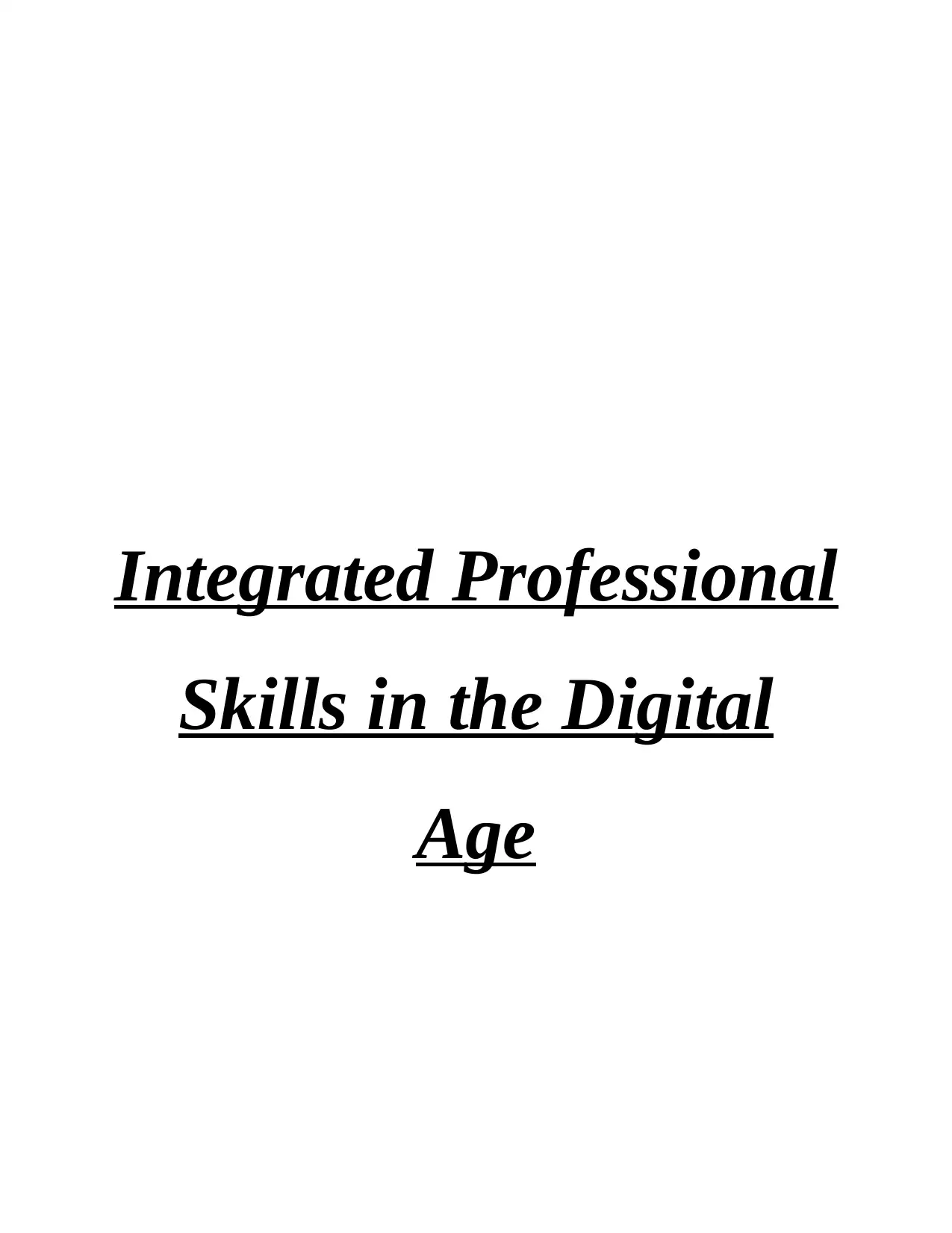
Integrated Professional
Skills in the Digital
Age
Skills in the Digital
Age
Paraphrase This Document
Need a fresh take? Get an instant paraphrase of this document with our AI Paraphraser
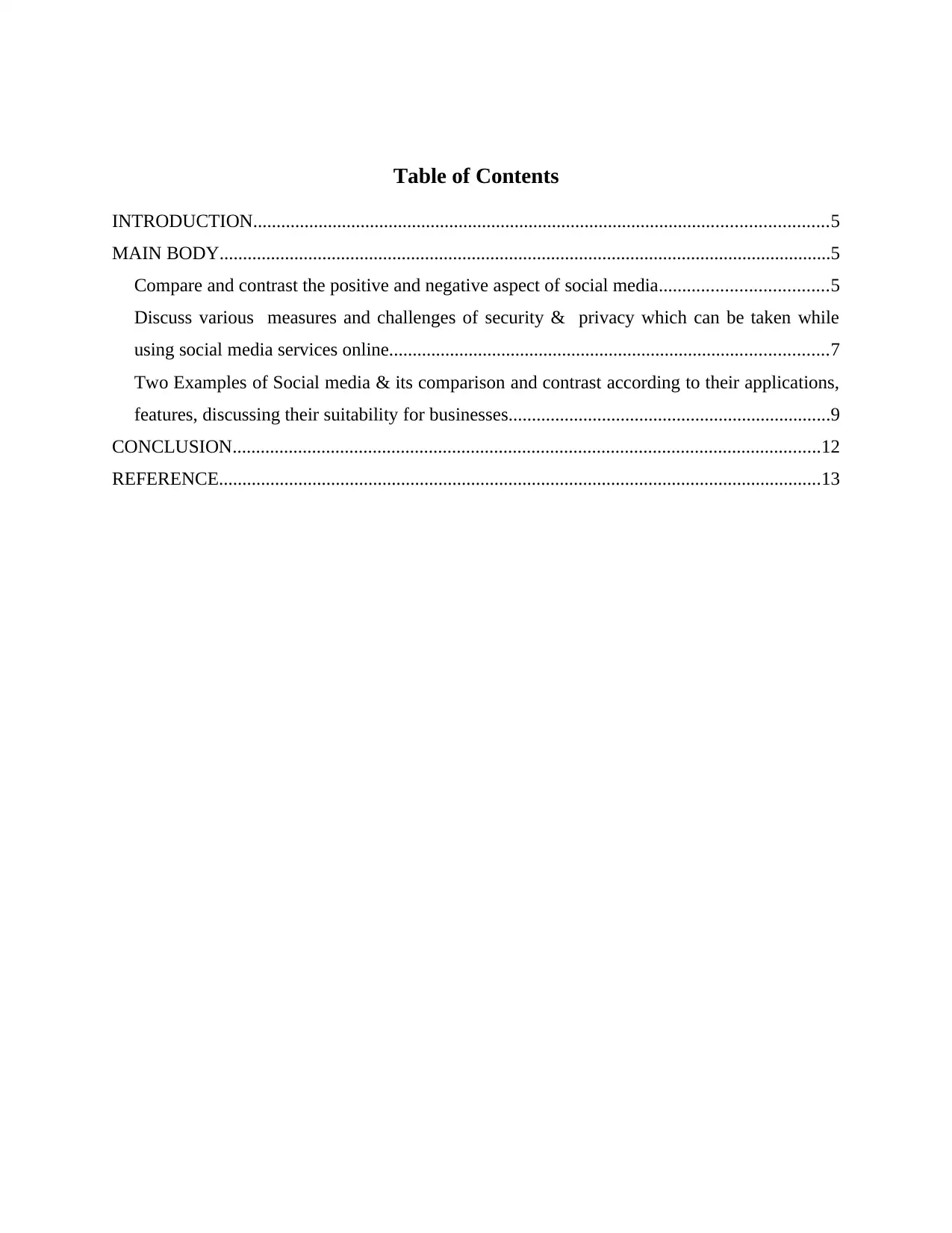
Table of Contents
INTRODUCTION...........................................................................................................................5
MAIN BODY...................................................................................................................................5
Compare and contrast the positive and negative aspect of social media....................................5
Discuss various measures and challenges of security & privacy which can be taken while
using social media services online..............................................................................................7
Two Examples of Social media & its comparison and contrast according to their applications,
features, discussing their suitability for businesses.....................................................................9
CONCLUSION..............................................................................................................................12
REFERENCE.................................................................................................................................13
INTRODUCTION...........................................................................................................................5
MAIN BODY...................................................................................................................................5
Compare and contrast the positive and negative aspect of social media....................................5
Discuss various measures and challenges of security & privacy which can be taken while
using social media services online..............................................................................................7
Two Examples of Social media & its comparison and contrast according to their applications,
features, discussing their suitability for businesses.....................................................................9
CONCLUSION..............................................................................................................................12
REFERENCE.................................................................................................................................13
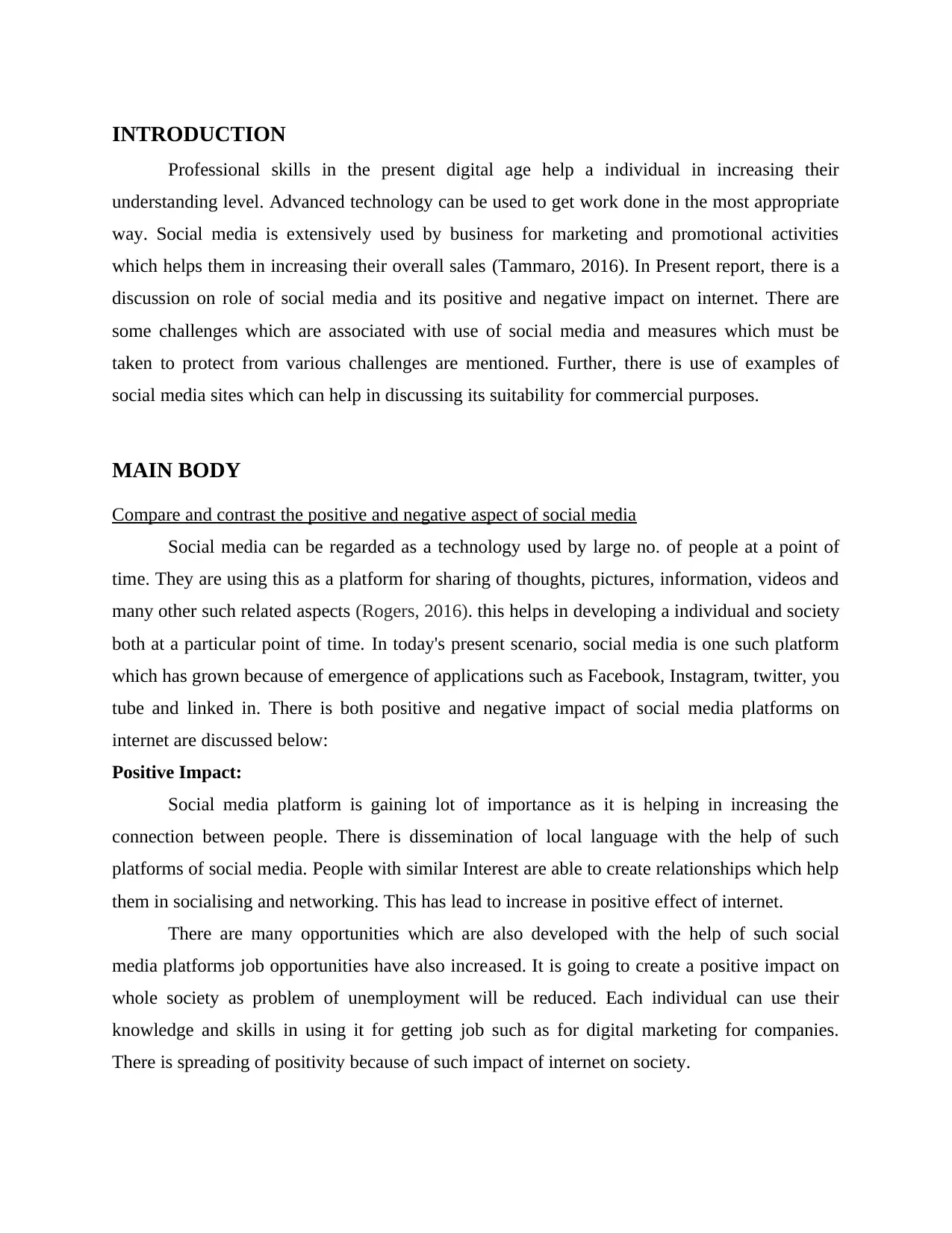
INTRODUCTION
Professional skills in the present digital age help a individual in increasing their
understanding level. Advanced technology can be used to get work done in the most appropriate
way. Social media is extensively used by business for marketing and promotional activities
which helps them in increasing their overall sales (Tammaro, 2016). In Present report, there is a
discussion on role of social media and its positive and negative impact on internet. There are
some challenges which are associated with use of social media and measures which must be
taken to protect from various challenges are mentioned. Further, there is use of examples of
social media sites which can help in discussing its suitability for commercial purposes.
MAIN BODY
Compare and contrast the positive and negative aspect of social media
Social media can be regarded as a technology used by large no. of people at a point of
time. They are using this as a platform for sharing of thoughts, pictures, information, videos and
many other such related aspects (Rogers, 2016). this helps in developing a individual and society
both at a particular point of time. In today's present scenario, social media is one such platform
which has grown because of emergence of applications such as Facebook, Instagram, twitter, you
tube and linked in. There is both positive and negative impact of social media platforms on
internet are discussed below:
Positive Impact:
Social media platform is gaining lot of importance as it is helping in increasing the
connection between people. There is dissemination of local language with the help of such
platforms of social media. People with similar Interest are able to create relationships which help
them in socialising and networking. This has lead to increase in positive effect of internet.
There are many opportunities which are also developed with the help of such social
media platforms job opportunities have also increased. It is going to create a positive impact on
whole society as problem of unemployment will be reduced. Each individual can use their
knowledge and skills in using it for getting job such as for digital marketing for companies.
There is spreading of positivity because of such impact of internet on society.
Professional skills in the present digital age help a individual in increasing their
understanding level. Advanced technology can be used to get work done in the most appropriate
way. Social media is extensively used by business for marketing and promotional activities
which helps them in increasing their overall sales (Tammaro, 2016). In Present report, there is a
discussion on role of social media and its positive and negative impact on internet. There are
some challenges which are associated with use of social media and measures which must be
taken to protect from various challenges are mentioned. Further, there is use of examples of
social media sites which can help in discussing its suitability for commercial purposes.
MAIN BODY
Compare and contrast the positive and negative aspect of social media
Social media can be regarded as a technology used by large no. of people at a point of
time. They are using this as a platform for sharing of thoughts, pictures, information, videos and
many other such related aspects (Rogers, 2016). this helps in developing a individual and society
both at a particular point of time. In today's present scenario, social media is one such platform
which has grown because of emergence of applications such as Facebook, Instagram, twitter, you
tube and linked in. There is both positive and negative impact of social media platforms on
internet are discussed below:
Positive Impact:
Social media platform is gaining lot of importance as it is helping in increasing the
connection between people. There is dissemination of local language with the help of such
platforms of social media. People with similar Interest are able to create relationships which help
them in socialising and networking. This has lead to increase in positive effect of internet.
There are many opportunities which are also developed with the help of such social
media platforms job opportunities have also increased. It is going to create a positive impact on
whole society as problem of unemployment will be reduced. Each individual can use their
knowledge and skills in using it for getting job such as for digital marketing for companies.
There is spreading of positivity because of such impact of internet on society.
⊘ This is a preview!⊘
Do you want full access?
Subscribe today to unlock all pages.

Trusted by 1+ million students worldwide
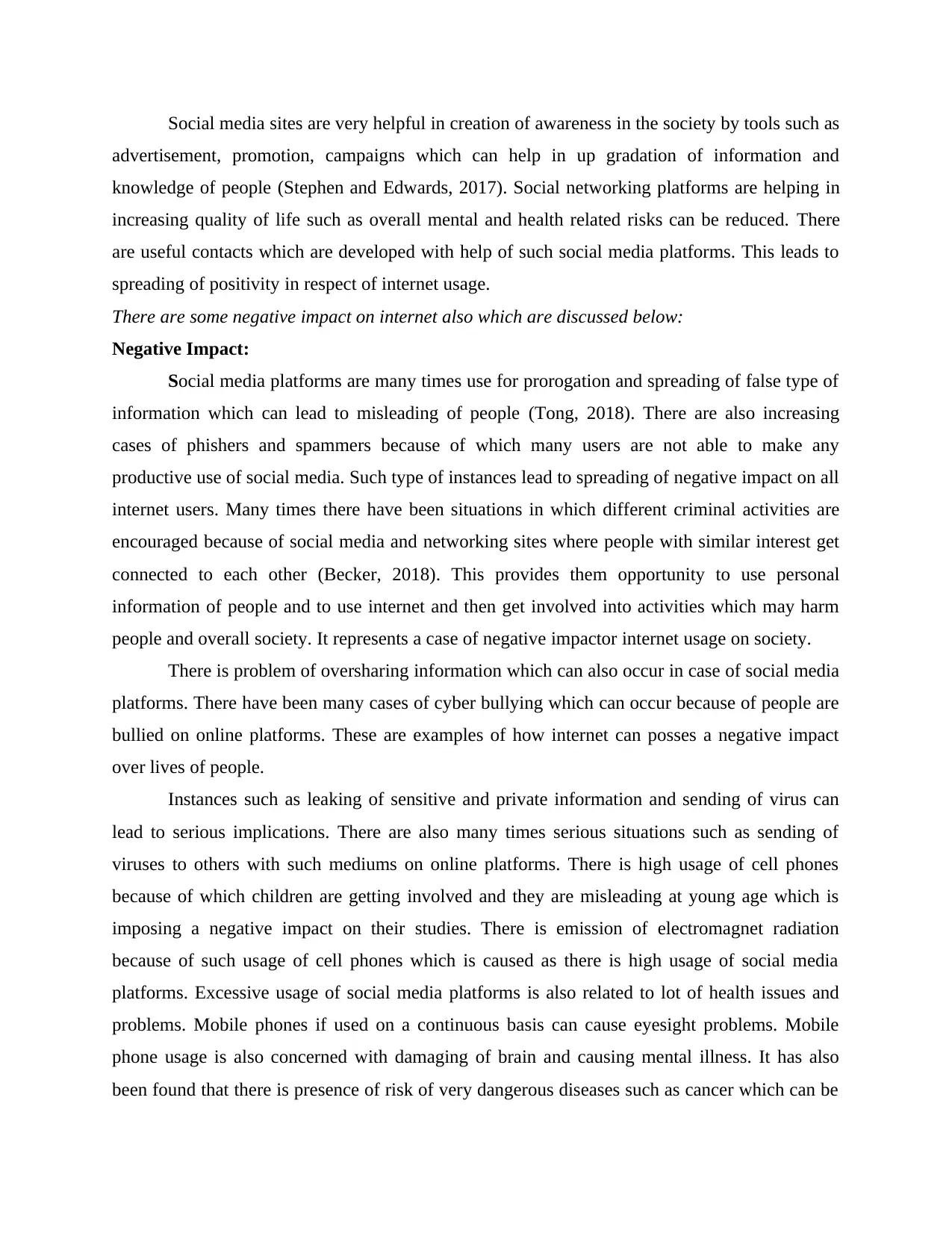
Social media sites are very helpful in creation of awareness in the society by tools such as
advertisement, promotion, campaigns which can help in up gradation of information and
knowledge of people (Stephen and Edwards, 2017). Social networking platforms are helping in
increasing quality of life such as overall mental and health related risks can be reduced. There
are useful contacts which are developed with help of such social media platforms. This leads to
spreading of positivity in respect of internet usage.
There are some negative impact on internet also which are discussed below:
Negative Impact:
Social media platforms are many times use for prorogation and spreading of false type of
information which can lead to misleading of people (Tong, 2018). There are also increasing
cases of phishers and spammers because of which many users are not able to make any
productive use of social media. Such type of instances lead to spreading of negative impact on all
internet users. Many times there have been situations in which different criminal activities are
encouraged because of social media and networking sites where people with similar interest get
connected to each other (Becker, 2018). This provides them opportunity to use personal
information of people and to use internet and then get involved into activities which may harm
people and overall society. It represents a case of negative impactor internet usage on society.
There is problem of oversharing information which can also occur in case of social media
platforms. There have been many cases of cyber bullying which can occur because of people are
bullied on online platforms. These are examples of how internet can posses a negative impact
over lives of people.
Instances such as leaking of sensitive and private information and sending of virus can
lead to serious implications. There are also many times serious situations such as sending of
viruses to others with such mediums on online platforms. There is high usage of cell phones
because of which children are getting involved and they are misleading at young age which is
imposing a negative impact on their studies. There is emission of electromagnet radiation
because of such usage of cell phones which is caused as there is high usage of social media
platforms. Excessive usage of social media platforms is also related to lot of health issues and
problems. Mobile phones if used on a continuous basis can cause eyesight problems. Mobile
phone usage is also concerned with damaging of brain and causing mental illness. It has also
been found that there is presence of risk of very dangerous diseases such as cancer which can be
advertisement, promotion, campaigns which can help in up gradation of information and
knowledge of people (Stephen and Edwards, 2017). Social networking platforms are helping in
increasing quality of life such as overall mental and health related risks can be reduced. There
are useful contacts which are developed with help of such social media platforms. This leads to
spreading of positivity in respect of internet usage.
There are some negative impact on internet also which are discussed below:
Negative Impact:
Social media platforms are many times use for prorogation and spreading of false type of
information which can lead to misleading of people (Tong, 2018). There are also increasing
cases of phishers and spammers because of which many users are not able to make any
productive use of social media. Such type of instances lead to spreading of negative impact on all
internet users. Many times there have been situations in which different criminal activities are
encouraged because of social media and networking sites where people with similar interest get
connected to each other (Becker, 2018). This provides them opportunity to use personal
information of people and to use internet and then get involved into activities which may harm
people and overall society. It represents a case of negative impactor internet usage on society.
There is problem of oversharing information which can also occur in case of social media
platforms. There have been many cases of cyber bullying which can occur because of people are
bullied on online platforms. These are examples of how internet can posses a negative impact
over lives of people.
Instances such as leaking of sensitive and private information and sending of virus can
lead to serious implications. There are also many times serious situations such as sending of
viruses to others with such mediums on online platforms. There is high usage of cell phones
because of which children are getting involved and they are misleading at young age which is
imposing a negative impact on their studies. There is emission of electromagnet radiation
because of such usage of cell phones which is caused as there is high usage of social media
platforms. Excessive usage of social media platforms is also related to lot of health issues and
problems. Mobile phones if used on a continuous basis can cause eyesight problems. Mobile
phone usage is also concerned with damaging of brain and causing mental illness. It has also
been found that there is presence of risk of very dangerous diseases such as cancer which can be
Paraphrase This Document
Need a fresh take? Get an instant paraphrase of this document with our AI Paraphraser
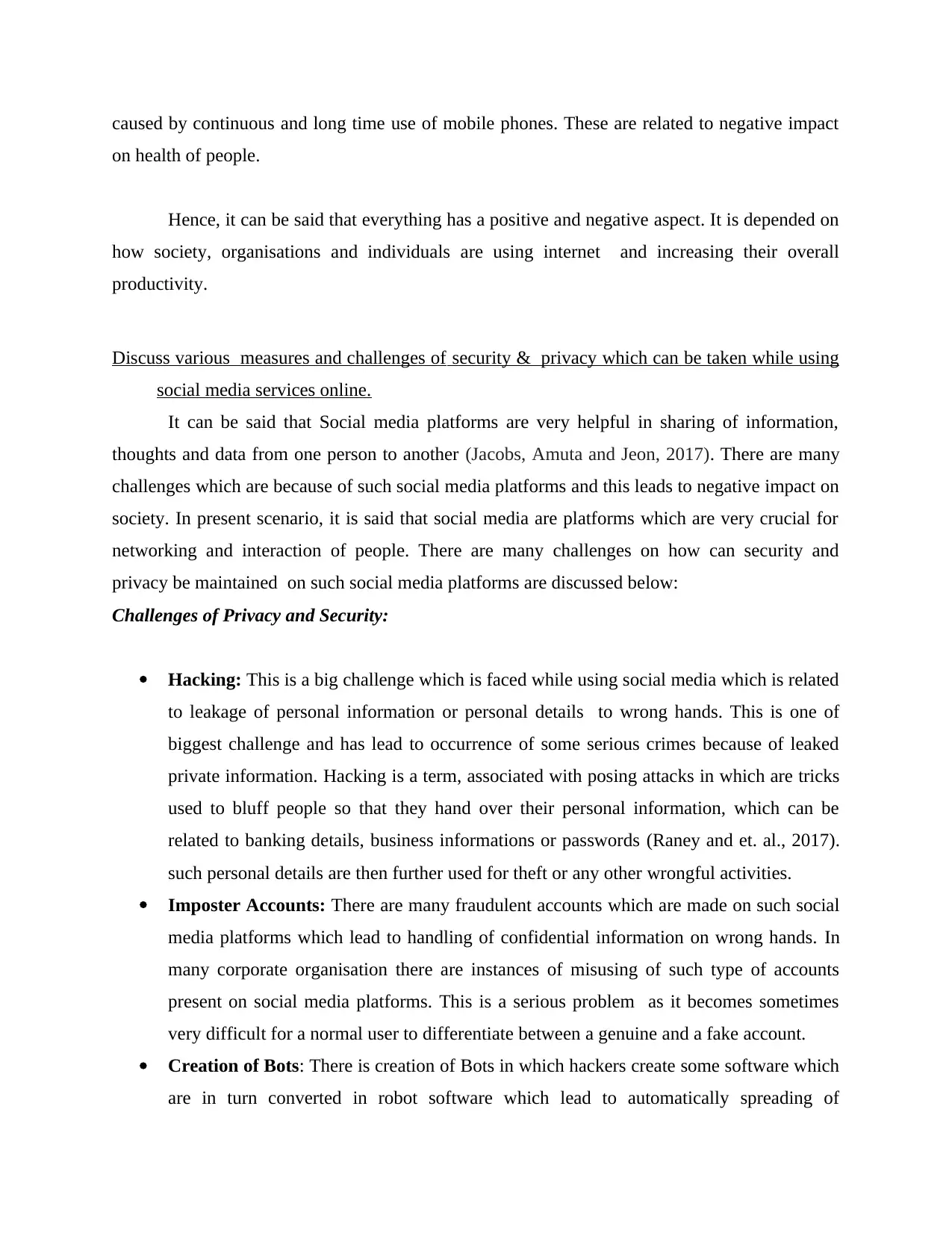
caused by continuous and long time use of mobile phones. These are related to negative impact
on health of people.
Hence, it can be said that everything has a positive and negative aspect. It is depended on
how society, organisations and individuals are using internet and increasing their overall
productivity.
Discuss various measures and challenges of security & privacy which can be taken while using
social media services online.
It can be said that Social media platforms are very helpful in sharing of information,
thoughts and data from one person to another (Jacobs, Amuta and Jeon, 2017). There are many
challenges which are because of such social media platforms and this leads to negative impact on
society. In present scenario, it is said that social media are platforms which are very crucial for
networking and interaction of people. There are many challenges on how can security and
privacy be maintained on such social media platforms are discussed below:
Challenges of Privacy and Security:
Hacking: This is a big challenge which is faced while using social media which is related
to leakage of personal information or personal details to wrong hands. This is one of
biggest challenge and has lead to occurrence of some serious crimes because of leaked
private information. Hacking is a term, associated with posing attacks in which are tricks
used to bluff people so that they hand over their personal information, which can be
related to banking details, business informations or passwords (Raney and et. al., 2017).
such personal details are then further used for theft or any other wrongful activities.
Imposter Accounts: There are many fraudulent accounts which are made on such social
media platforms which lead to handling of confidential information on wrong hands. In
many corporate organisation there are instances of misusing of such type of accounts
present on social media platforms. This is a serious problem as it becomes sometimes
very difficult for a normal user to differentiate between a genuine and a fake account.
Creation of Bots: There is creation of Bots in which hackers create some software which
are in turn converted in robot software which lead to automatically spreading of
on health of people.
Hence, it can be said that everything has a positive and negative aspect. It is depended on
how society, organisations and individuals are using internet and increasing their overall
productivity.
Discuss various measures and challenges of security & privacy which can be taken while using
social media services online.
It can be said that Social media platforms are very helpful in sharing of information,
thoughts and data from one person to another (Jacobs, Amuta and Jeon, 2017). There are many
challenges which are because of such social media platforms and this leads to negative impact on
society. In present scenario, it is said that social media are platforms which are very crucial for
networking and interaction of people. There are many challenges on how can security and
privacy be maintained on such social media platforms are discussed below:
Challenges of Privacy and Security:
Hacking: This is a big challenge which is faced while using social media which is related
to leakage of personal information or personal details to wrong hands. This is one of
biggest challenge and has lead to occurrence of some serious crimes because of leaked
private information. Hacking is a term, associated with posing attacks in which are tricks
used to bluff people so that they hand over their personal information, which can be
related to banking details, business informations or passwords (Raney and et. al., 2017).
such personal details are then further used for theft or any other wrongful activities.
Imposter Accounts: There are many fraudulent accounts which are made on such social
media platforms which lead to handling of confidential information on wrong hands. In
many corporate organisation there are instances of misusing of such type of accounts
present on social media platforms. This is a serious problem as it becomes sometimes
very difficult for a normal user to differentiate between a genuine and a fake account.
Creation of Bots: There is creation of Bots in which hackers create some software which
are in turn converted in robot software which lead to automatically spreading of
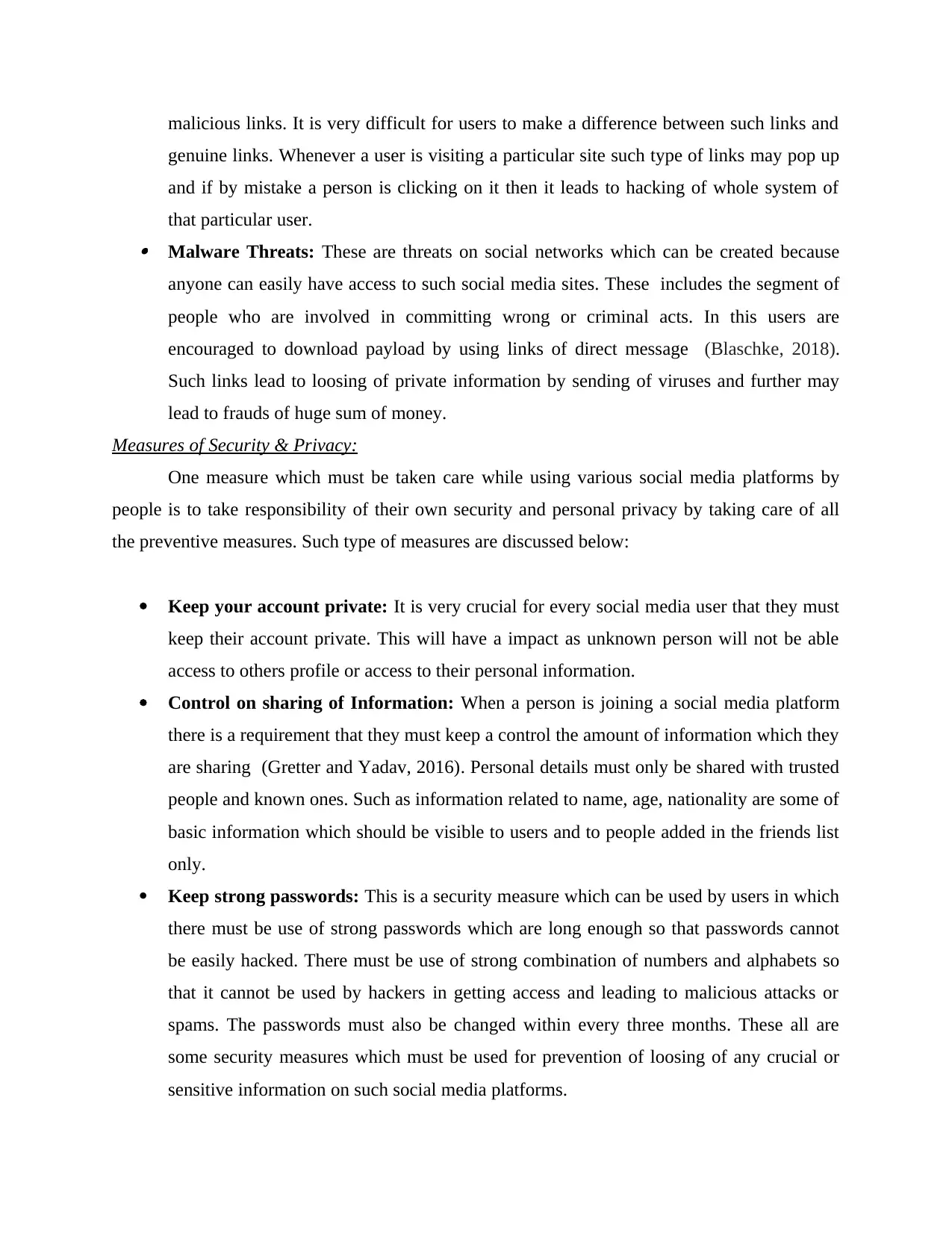
malicious links. It is very difficult for users to make a difference between such links and
genuine links. Whenever a user is visiting a particular site such type of links may pop up
and if by mistake a person is clicking on it then it leads to hacking of whole system of
that particular user. Malware Threats: These are threats on social networks which can be created because
anyone can easily have access to such social media sites. These includes the segment of
people who are involved in committing wrong or criminal acts. In this users are
encouraged to download payload by using links of direct message (Blaschke, 2018).
Such links lead to loosing of private information by sending of viruses and further may
lead to frauds of huge sum of money.
Measures of Security & Privacy:
One measure which must be taken care while using various social media platforms by
people is to take responsibility of their own security and personal privacy by taking care of all
the preventive measures. Such type of measures are discussed below:
Keep your account private: It is very crucial for every social media user that they must
keep their account private. This will have a impact as unknown person will not be able
access to others profile or access to their personal information.
Control on sharing of Information: When a person is joining a social media platform
there is a requirement that they must keep a control the amount of information which they
are sharing (Gretter and Yadav, 2016). Personal details must only be shared with trusted
people and known ones. Such as information related to name, age, nationality are some of
basic information which should be visible to users and to people added in the friends list
only.
Keep strong passwords: This is a security measure which can be used by users in which
there must be use of strong passwords which are long enough so that passwords cannot
be easily hacked. There must be use of strong combination of numbers and alphabets so
that it cannot be used by hackers in getting access and leading to malicious attacks or
spams. The passwords must also be changed within every three months. These all are
some security measures which must be used for prevention of loosing of any crucial or
sensitive information on such social media platforms.
genuine links. Whenever a user is visiting a particular site such type of links may pop up
and if by mistake a person is clicking on it then it leads to hacking of whole system of
that particular user. Malware Threats: These are threats on social networks which can be created because
anyone can easily have access to such social media sites. These includes the segment of
people who are involved in committing wrong or criminal acts. In this users are
encouraged to download payload by using links of direct message (Blaschke, 2018).
Such links lead to loosing of private information by sending of viruses and further may
lead to frauds of huge sum of money.
Measures of Security & Privacy:
One measure which must be taken care while using various social media platforms by
people is to take responsibility of their own security and personal privacy by taking care of all
the preventive measures. Such type of measures are discussed below:
Keep your account private: It is very crucial for every social media user that they must
keep their account private. This will have a impact as unknown person will not be able
access to others profile or access to their personal information.
Control on sharing of Information: When a person is joining a social media platform
there is a requirement that they must keep a control the amount of information which they
are sharing (Gretter and Yadav, 2016). Personal details must only be shared with trusted
people and known ones. Such as information related to name, age, nationality are some of
basic information which should be visible to users and to people added in the friends list
only.
Keep strong passwords: This is a security measure which can be used by users in which
there must be use of strong passwords which are long enough so that passwords cannot
be easily hacked. There must be use of strong combination of numbers and alphabets so
that it cannot be used by hackers in getting access and leading to malicious attacks or
spams. The passwords must also be changed within every three months. These all are
some security measures which must be used for prevention of loosing of any crucial or
sensitive information on such social media platforms.
⊘ This is a preview!⊘
Do you want full access?
Subscribe today to unlock all pages.

Trusted by 1+ million students worldwide
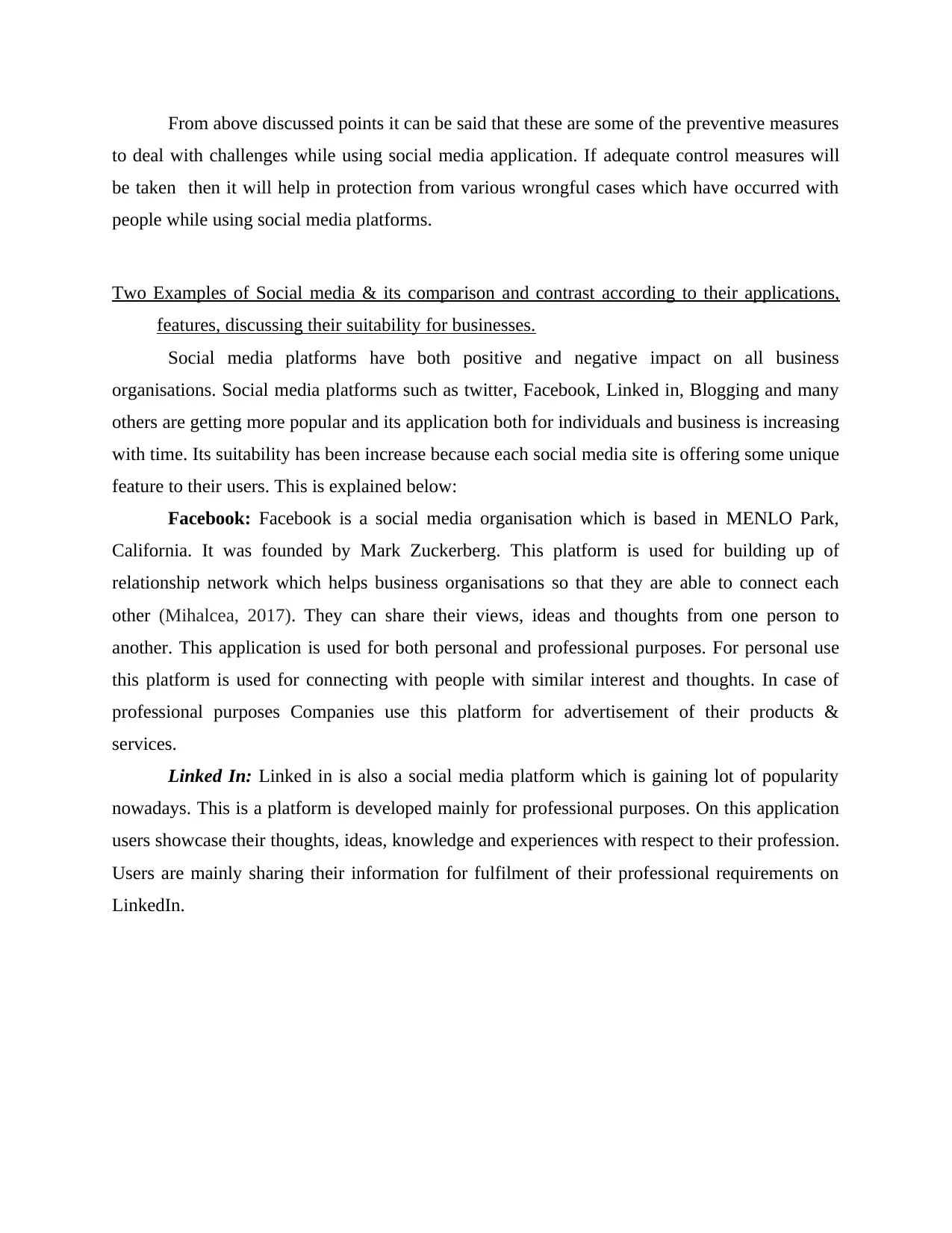
From above discussed points it can be said that these are some of the preventive measures
to deal with challenges while using social media application. If adequate control measures will
be taken then it will help in protection from various wrongful cases which have occurred with
people while using social media platforms.
Two Examples of Social media & its comparison and contrast according to their applications,
features, discussing their suitability for businesses.
Social media platforms have both positive and negative impact on all business
organisations. Social media platforms such as twitter, Facebook, Linked in, Blogging and many
others are getting more popular and its application both for individuals and business is increasing
with time. Its suitability has been increase because each social media site is offering some unique
feature to their users. This is explained below:
Facebook: Facebook is a social media organisation which is based in MENLO Park,
California. It was founded by Mark Zuckerberg. This platform is used for building up of
relationship network which helps business organisations so that they are able to connect each
other (Mihalcea, 2017). They can share their views, ideas and thoughts from one person to
another. This application is used for both personal and professional purposes. For personal use
this platform is used for connecting with people with similar interest and thoughts. In case of
professional purposes Companies use this platform for advertisement of their products &
services.
Linked In: Linked in is also a social media platform which is gaining lot of popularity
nowadays. This is a platform is developed mainly for professional purposes. On this application
users showcase their thoughts, ideas, knowledge and experiences with respect to their profession.
Users are mainly sharing their information for fulfilment of their professional requirements on
LinkedIn.
to deal with challenges while using social media application. If adequate control measures will
be taken then it will help in protection from various wrongful cases which have occurred with
people while using social media platforms.
Two Examples of Social media & its comparison and contrast according to their applications,
features, discussing their suitability for businesses.
Social media platforms have both positive and negative impact on all business
organisations. Social media platforms such as twitter, Facebook, Linked in, Blogging and many
others are getting more popular and its application both for individuals and business is increasing
with time. Its suitability has been increase because each social media site is offering some unique
feature to their users. This is explained below:
Facebook: Facebook is a social media organisation which is based in MENLO Park,
California. It was founded by Mark Zuckerberg. This platform is used for building up of
relationship network which helps business organisations so that they are able to connect each
other (Mihalcea, 2017). They can share their views, ideas and thoughts from one person to
another. This application is used for both personal and professional purposes. For personal use
this platform is used for connecting with people with similar interest and thoughts. In case of
professional purposes Companies use this platform for advertisement of their products &
services.
Linked In: Linked in is also a social media platform which is gaining lot of popularity
nowadays. This is a platform is developed mainly for professional purposes. On this application
users showcase their thoughts, ideas, knowledge and experiences with respect to their profession.
Users are mainly sharing their information for fulfilment of their professional requirements on
LinkedIn.
Paraphrase This Document
Need a fresh take? Get an instant paraphrase of this document with our AI Paraphraser
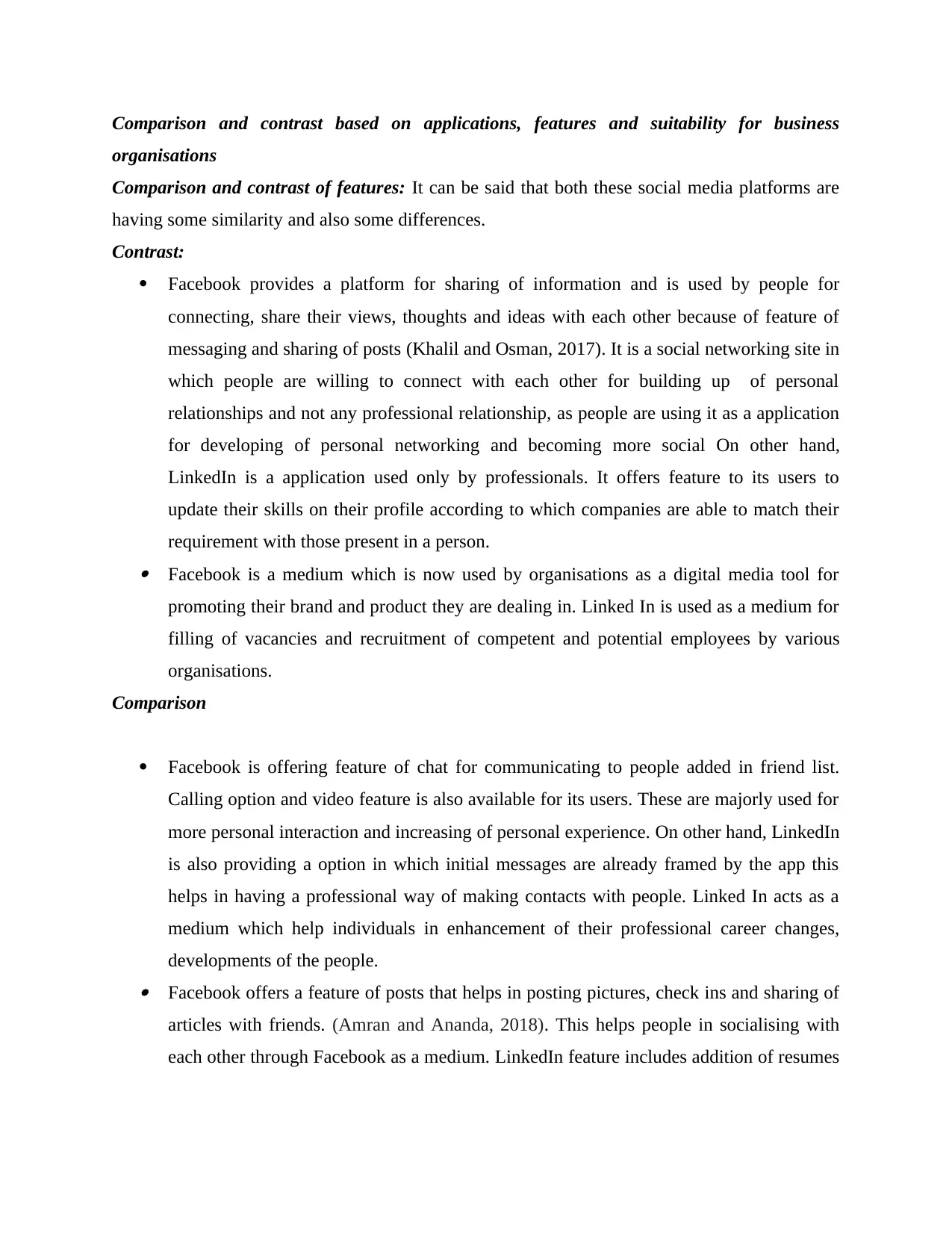
Comparison and contrast based on applications, features and suitability for business
organisations
Comparison and contrast of features: It can be said that both these social media platforms are
having some similarity and also some differences.
Contrast:
Facebook provides a platform for sharing of information and is used by people for
connecting, share their views, thoughts and ideas with each other because of feature of
messaging and sharing of posts (Khalil and Osman, 2017). It is a social networking site in
which people are willing to connect with each other for building up of personal
relationships and not any professional relationship, as people are using it as a application
for developing of personal networking and becoming more social On other hand,
LinkedIn is a application used only by professionals. It offers feature to its users to
update their skills on their profile according to which companies are able to match their
requirement with those present in a person. Facebook is a medium which is now used by organisations as a digital media tool for
promoting their brand and product they are dealing in. Linked In is used as a medium for
filling of vacancies and recruitment of competent and potential employees by various
organisations.
Comparison
Facebook is offering feature of chat for communicating to people added in friend list.
Calling option and video feature is also available for its users. These are majorly used for
more personal interaction and increasing of personal experience. On other hand, LinkedIn
is also providing a option in which initial messages are already framed by the app this
helps in having a professional way of making contacts with people. Linked In acts as a
medium which help individuals in enhancement of their professional career changes,
developments of the people. Facebook offers a feature of posts that helps in posting pictures, check ins and sharing of
articles with friends. (Amran and Ananda, 2018). This helps people in socialising with
each other through Facebook as a medium. LinkedIn feature includes addition of resumes
organisations
Comparison and contrast of features: It can be said that both these social media platforms are
having some similarity and also some differences.
Contrast:
Facebook provides a platform for sharing of information and is used by people for
connecting, share their views, thoughts and ideas with each other because of feature of
messaging and sharing of posts (Khalil and Osman, 2017). It is a social networking site in
which people are willing to connect with each other for building up of personal
relationships and not any professional relationship, as people are using it as a application
for developing of personal networking and becoming more social On other hand,
LinkedIn is a application used only by professionals. It offers feature to its users to
update their skills on their profile according to which companies are able to match their
requirement with those present in a person. Facebook is a medium which is now used by organisations as a digital media tool for
promoting their brand and product they are dealing in. Linked In is used as a medium for
filling of vacancies and recruitment of competent and potential employees by various
organisations.
Comparison
Facebook is offering feature of chat for communicating to people added in friend list.
Calling option and video feature is also available for its users. These are majorly used for
more personal interaction and increasing of personal experience. On other hand, LinkedIn
is also providing a option in which initial messages are already framed by the app this
helps in having a professional way of making contacts with people. Linked In acts as a
medium which help individuals in enhancement of their professional career changes,
developments of the people. Facebook offers a feature of posts that helps in posting pictures, check ins and sharing of
articles with friends. (Amran and Ananda, 2018). This helps people in socialising with
each other through Facebook as a medium. LinkedIn feature includes addition of resumes
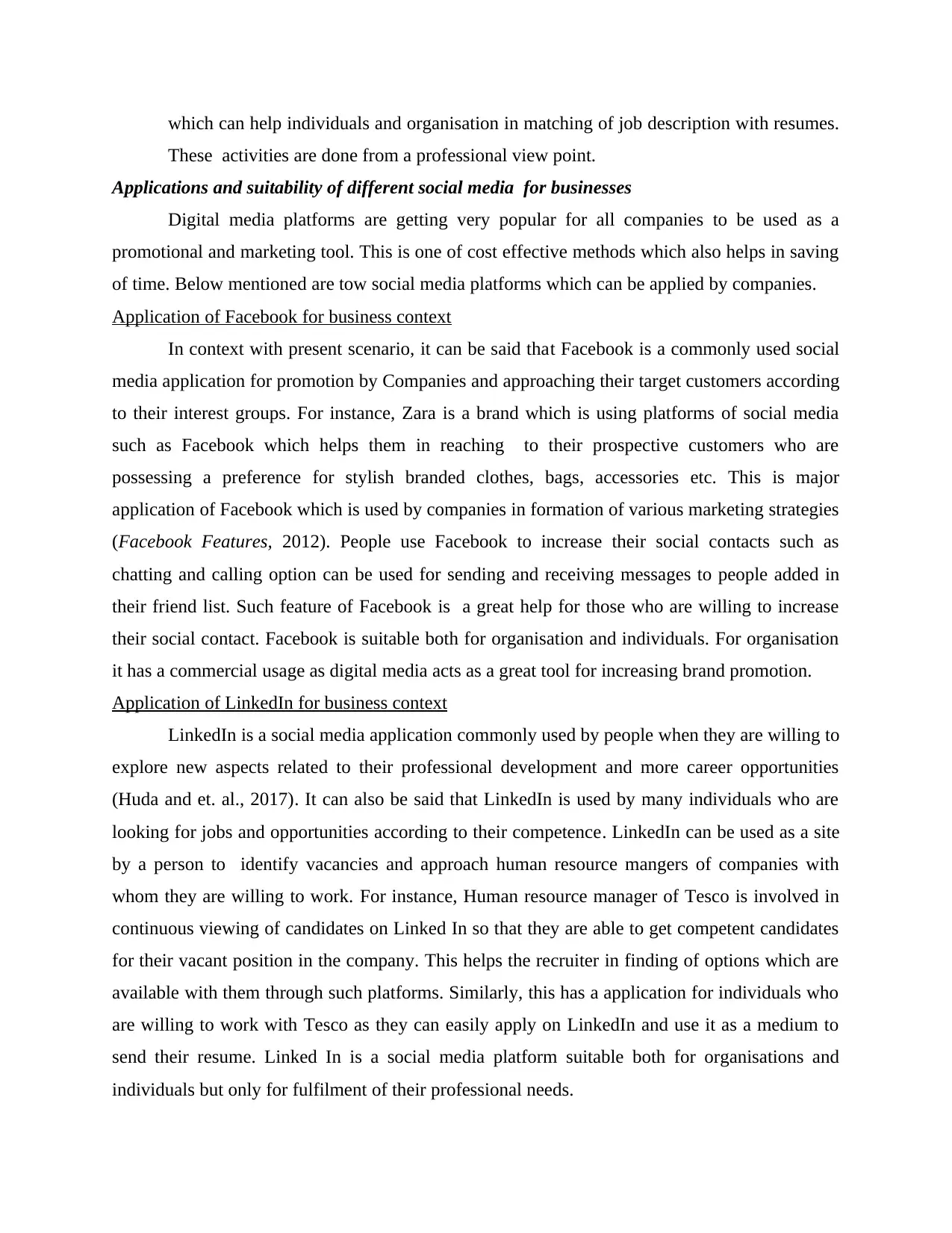
which can help individuals and organisation in matching of job description with resumes.
These activities are done from a professional view point.
Applications and suitability of different social media for businesses
Digital media platforms are getting very popular for all companies to be used as a
promotional and marketing tool. This is one of cost effective methods which also helps in saving
of time. Below mentioned are tow social media platforms which can be applied by companies.
Application of Facebook for business context
In context with present scenario, it can be said that Facebook is a commonly used social
media application for promotion by Companies and approaching their target customers according
to their interest groups. For instance, Zara is a brand which is using platforms of social media
such as Facebook which helps them in reaching to their prospective customers who are
possessing a preference for stylish branded clothes, bags, accessories etc. This is major
application of Facebook which is used by companies in formation of various marketing strategies
(Facebook Features, 2012). People use Facebook to increase their social contacts such as
chatting and calling option can be used for sending and receiving messages to people added in
their friend list. Such feature of Facebook is a great help for those who are willing to increase
their social contact. Facebook is suitable both for organisation and individuals. For organisation
it has a commercial usage as digital media acts as a great tool for increasing brand promotion.
Application of LinkedIn for business context
LinkedIn is a social media application commonly used by people when they are willing to
explore new aspects related to their professional development and more career opportunities
(Huda and et. al., 2017). It can also be said that LinkedIn is used by many individuals who are
looking for jobs and opportunities according to their competence. LinkedIn can be used as a site
by a person to identify vacancies and approach human resource mangers of companies with
whom they are willing to work. For instance, Human resource manager of Tesco is involved in
continuous viewing of candidates on Linked In so that they are able to get competent candidates
for their vacant position in the company. This helps the recruiter in finding of options which are
available with them through such platforms. Similarly, this has a application for individuals who
are willing to work with Tesco as they can easily apply on LinkedIn and use it as a medium to
send their resume. Linked In is a social media platform suitable both for organisations and
individuals but only for fulfilment of their professional needs.
These activities are done from a professional view point.
Applications and suitability of different social media for businesses
Digital media platforms are getting very popular for all companies to be used as a
promotional and marketing tool. This is one of cost effective methods which also helps in saving
of time. Below mentioned are tow social media platforms which can be applied by companies.
Application of Facebook for business context
In context with present scenario, it can be said that Facebook is a commonly used social
media application for promotion by Companies and approaching their target customers according
to their interest groups. For instance, Zara is a brand which is using platforms of social media
such as Facebook which helps them in reaching to their prospective customers who are
possessing a preference for stylish branded clothes, bags, accessories etc. This is major
application of Facebook which is used by companies in formation of various marketing strategies
(Facebook Features, 2012). People use Facebook to increase their social contacts such as
chatting and calling option can be used for sending and receiving messages to people added in
their friend list. Such feature of Facebook is a great help for those who are willing to increase
their social contact. Facebook is suitable both for organisation and individuals. For organisation
it has a commercial usage as digital media acts as a great tool for increasing brand promotion.
Application of LinkedIn for business context
LinkedIn is a social media application commonly used by people when they are willing to
explore new aspects related to their professional development and more career opportunities
(Huda and et. al., 2017). It can also be said that LinkedIn is used by many individuals who are
looking for jobs and opportunities according to their competence. LinkedIn can be used as a site
by a person to identify vacancies and approach human resource mangers of companies with
whom they are willing to work. For instance, Human resource manager of Tesco is involved in
continuous viewing of candidates on Linked In so that they are able to get competent candidates
for their vacant position in the company. This helps the recruiter in finding of options which are
available with them through such platforms. Similarly, this has a application for individuals who
are willing to work with Tesco as they can easily apply on LinkedIn and use it as a medium to
send their resume. Linked In is a social media platform suitable both for organisations and
individuals but only for fulfilment of their professional needs.
⊘ This is a preview!⊘
Do you want full access?
Subscribe today to unlock all pages.

Trusted by 1+ million students worldwide
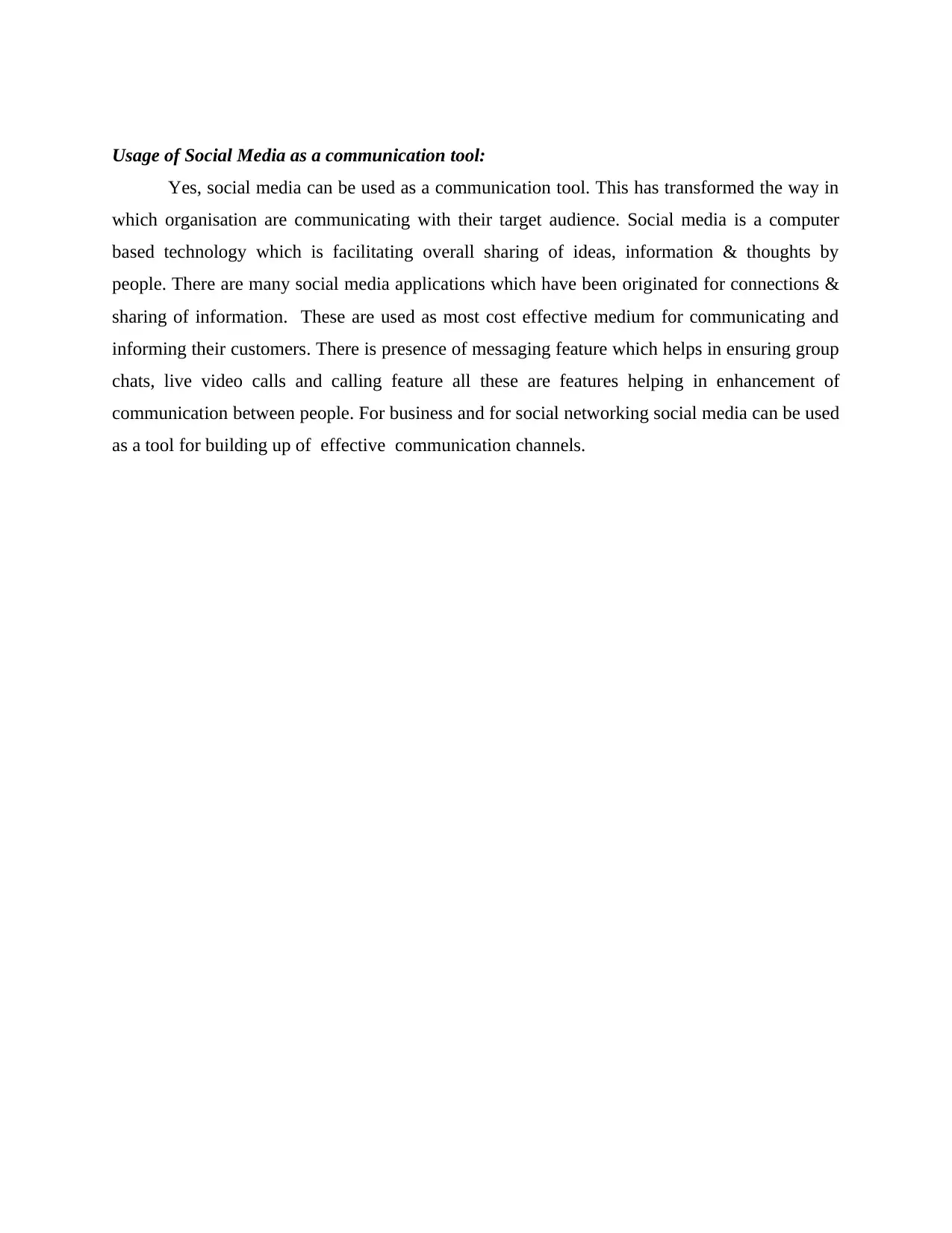
Usage of Social Media as a communication tool:
Yes, social media can be used as a communication tool. This has transformed the way in
which organisation are communicating with their target audience. Social media is a computer
based technology which is facilitating overall sharing of ideas, information & thoughts by
people. There are many social media applications which have been originated for connections &
sharing of information. These are used as most cost effective medium for communicating and
informing their customers. There is presence of messaging feature which helps in ensuring group
chats, live video calls and calling feature all these are features helping in enhancement of
communication between people. For business and for social networking social media can be used
as a tool for building up of effective communication channels.
Yes, social media can be used as a communication tool. This has transformed the way in
which organisation are communicating with their target audience. Social media is a computer
based technology which is facilitating overall sharing of ideas, information & thoughts by
people. There are many social media applications which have been originated for connections &
sharing of information. These are used as most cost effective medium for communicating and
informing their customers. There is presence of messaging feature which helps in ensuring group
chats, live video calls and calling feature all these are features helping in enhancement of
communication between people. For business and for social networking social media can be used
as a tool for building up of effective communication channels.
Paraphrase This Document
Need a fresh take? Get an instant paraphrase of this document with our AI Paraphraser
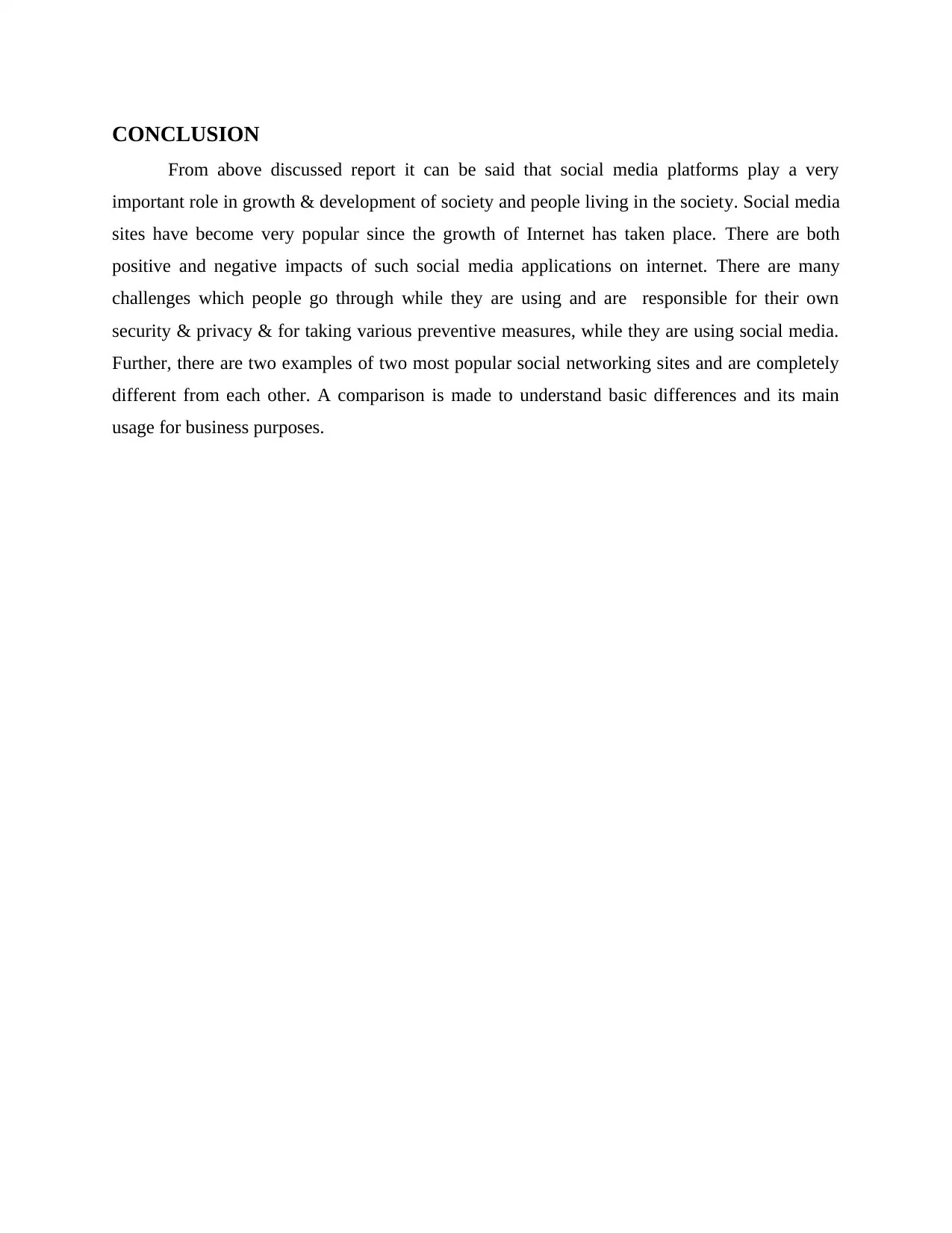
CONCLUSION
From above discussed report it can be said that social media platforms play a very
important role in growth & development of society and people living in the society. Social media
sites have become very popular since the growth of Internet has taken place. There are both
positive and negative impacts of such social media applications on internet. There are many
challenges which people go through while they are using and are responsible for their own
security & privacy & for taking various preventive measures, while they are using social media.
Further, there are two examples of two most popular social networking sites and are completely
different from each other. A comparison is made to understand basic differences and its main
usage for business purposes.
From above discussed report it can be said that social media platforms play a very
important role in growth & development of society and people living in the society. Social media
sites have become very popular since the growth of Internet has taken place. There are both
positive and negative impacts of such social media applications on internet. There are many
challenges which people go through while they are using and are responsible for their own
security & privacy & for taking various preventive measures, while they are using social media.
Further, there are two examples of two most popular social networking sites and are completely
different from each other. A comparison is made to understand basic differences and its main
usage for business purposes.
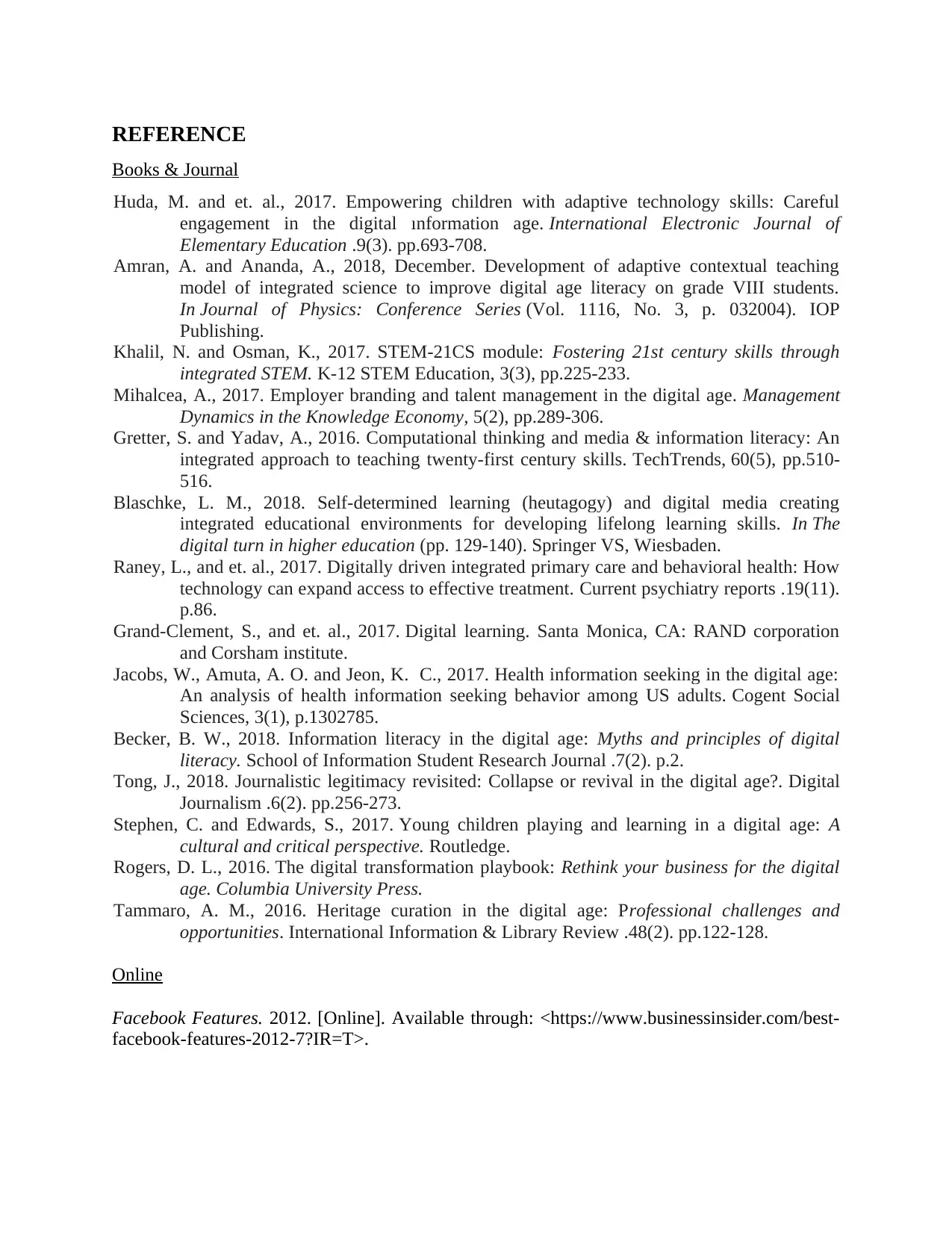
REFERENCE
Books & Journal
Huda, M. and et. al., 2017. Empowering children with adaptive technology skills: Careful
engagement in the digital ınformation age. International Electronic Journal of
Elementary Education .9(3). pp.693-708.
Amran, A. and Ananda, A., 2018, December. Development of adaptive contextual teaching
model of integrated science to improve digital age literacy on grade VIII students.
In Journal of Physics: Conference Series (Vol. 1116, No. 3, p. 032004). IOP
Publishing.
Khalil, N. and Osman, K., 2017. STEM-21CS module: Fostering 21st century skills through
integrated STEM. K-12 STEM Education, 3(3), pp.225-233.
Mihalcea, A., 2017. Employer branding and talent management in the digital age. Management
Dynamics in the Knowledge Economy, 5(2), pp.289-306.
Gretter, S. and Yadav, A., 2016. Computational thinking and media & information literacy: An
integrated approach to teaching twenty-first century skills. TechTrends, 60(5), pp.510-
516.
Blaschke, L. M., 2018. Self-determined learning (heutagogy) and digital media creating
integrated educational environments for developing lifelong learning skills. In The
digital turn in higher education (pp. 129-140). Springer VS, Wiesbaden.
Raney, L., and et. al., 2017. Digitally driven integrated primary care and behavioral health: How
technology can expand access to effective treatment. Current psychiatry reports .19(11).
p.86.
Grand-Clement, S., and et. al., 2017. Digital learning. Santa Monica, CA: RAND corporation
and Corsham institute.
Jacobs, W., Amuta, A. O. and Jeon, K. C., 2017. Health information seeking in the digital age:
An analysis of health information seeking behavior among US adults. Cogent Social
Sciences, 3(1), p.1302785.
Becker, B. W., 2018. Information literacy in the digital age: Myths and principles of digital
literacy. School of Information Student Research Journal .7(2). p.2.
Tong, J., 2018. Journalistic legitimacy revisited: Collapse or revival in the digital age?. Digital
Journalism .6(2). pp.256-273.
Stephen, C. and Edwards, S., 2017. Young children playing and learning in a digital age: A
cultural and critical perspective. Routledge.
Rogers, D. L., 2016. The digital transformation playbook: Rethink your business for the digital
age. Columbia University Press.
Tammaro, A. M., 2016. Heritage curation in the digital age: Professional challenges and
opportunities. International Information & Library Review .48(2). pp.122-128.
Online
Facebook Features. 2012. [Online]. Available through: <https://www.businessinsider.com/best-
facebook-features-2012-7?IR=T>.
Books & Journal
Huda, M. and et. al., 2017. Empowering children with adaptive technology skills: Careful
engagement in the digital ınformation age. International Electronic Journal of
Elementary Education .9(3). pp.693-708.
Amran, A. and Ananda, A., 2018, December. Development of adaptive contextual teaching
model of integrated science to improve digital age literacy on grade VIII students.
In Journal of Physics: Conference Series (Vol. 1116, No. 3, p. 032004). IOP
Publishing.
Khalil, N. and Osman, K., 2017. STEM-21CS module: Fostering 21st century skills through
integrated STEM. K-12 STEM Education, 3(3), pp.225-233.
Mihalcea, A., 2017. Employer branding and talent management in the digital age. Management
Dynamics in the Knowledge Economy, 5(2), pp.289-306.
Gretter, S. and Yadav, A., 2016. Computational thinking and media & information literacy: An
integrated approach to teaching twenty-first century skills. TechTrends, 60(5), pp.510-
516.
Blaschke, L. M., 2018. Self-determined learning (heutagogy) and digital media creating
integrated educational environments for developing lifelong learning skills. In The
digital turn in higher education (pp. 129-140). Springer VS, Wiesbaden.
Raney, L., and et. al., 2017. Digitally driven integrated primary care and behavioral health: How
technology can expand access to effective treatment. Current psychiatry reports .19(11).
p.86.
Grand-Clement, S., and et. al., 2017. Digital learning. Santa Monica, CA: RAND corporation
and Corsham institute.
Jacobs, W., Amuta, A. O. and Jeon, K. C., 2017. Health information seeking in the digital age:
An analysis of health information seeking behavior among US adults. Cogent Social
Sciences, 3(1), p.1302785.
Becker, B. W., 2018. Information literacy in the digital age: Myths and principles of digital
literacy. School of Information Student Research Journal .7(2). p.2.
Tong, J., 2018. Journalistic legitimacy revisited: Collapse or revival in the digital age?. Digital
Journalism .6(2). pp.256-273.
Stephen, C. and Edwards, S., 2017. Young children playing and learning in a digital age: A
cultural and critical perspective. Routledge.
Rogers, D. L., 2016. The digital transformation playbook: Rethink your business for the digital
age. Columbia University Press.
Tammaro, A. M., 2016. Heritage curation in the digital age: Professional challenges and
opportunities. International Information & Library Review .48(2). pp.122-128.
Online
Facebook Features. 2012. [Online]. Available through: <https://www.businessinsider.com/best-
facebook-features-2012-7?IR=T>.
⊘ This is a preview!⊘
Do you want full access?
Subscribe today to unlock all pages.

Trusted by 1+ million students worldwide
1 out of 12
Related Documents
Your All-in-One AI-Powered Toolkit for Academic Success.
+13062052269
info@desklib.com
Available 24*7 on WhatsApp / Email
![[object Object]](/_next/static/media/star-bottom.7253800d.svg)
Unlock your academic potential
Copyright © 2020–2025 A2Z Services. All Rights Reserved. Developed and managed by ZUCOL.





